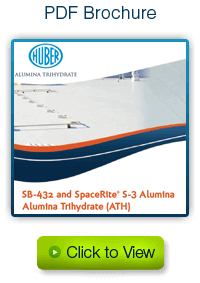Home > Chemical Industry Products > Halogen-Free Fire Retardant Additives > Huber Flame Retardant / Smoke Suppressant Applications > Industrial and Paper Coatings > Imparting Fire Retardance to Coatings
Imparting Fire Retardance to Coatings
Alumina trihydrate (ATH) is commonly used in fire retardant coatings because it is inert, has high brightness and low density and imparts fire retardance.
Customers will inquire: what ATH product does Huber recommend to impart fire retardance to our coating?
In order to answer, it is important to understand the details of your application. The choice of ATH grade depends on many variables:
- Fire Retardant Properties Required, Test Method
- Smoke Suppressant Properties, Test Method
- Substrate
- Film Thickness
- Coating Carrier (Water, Solvent, 100% Reactive)
- Resin Type
- Coating Texture (Smooth, Textured)
- Coating Gloss
- Pigmented or Clear
In general, to maximize fire retardance in coatings-related applications, Huber recommends:
1. Use the highest ATH loading possible while maintaining good paint properties – gloss, abrasion resistance, durability, contrast ratio, flow, leveling, etc.
2. Remove or minimize any ingredients that are flammable, such as plasticizers or coalescing additives which do not evaporate. (Phosphate ester plasticizers are suitable alternatives since they are not flammable.)
3. Replace other fillers (talc, calcium carbonate, etc.) which do not impart fire retardance with ATH.
4. Add ammonium polyphosphate (APP) if the fire retardance with ATH alone is not acceptable. APP and ATH are commonly used in coatings formulations.
Fire Retardance
 For water based acrylic elastomeric roof coatings, SB-432 ATH has been used for 30 years, and is recommended to impart fire retardance and SpaceRite® S-3 is a 1 micron ATH grade used to reduce TiO2 in elastomeric roof coatings. Read about both products by clicking on our brochure at right.
For water based acrylic elastomeric roof coatings, SB-432 ATH has been used for 30 years, and is recommended to impart fire retardance and SpaceRite® S-3 is a 1 micron ATH grade used to reduce TiO2 in elastomeric roof coatings. Read about both products by clicking on our brochure at right.